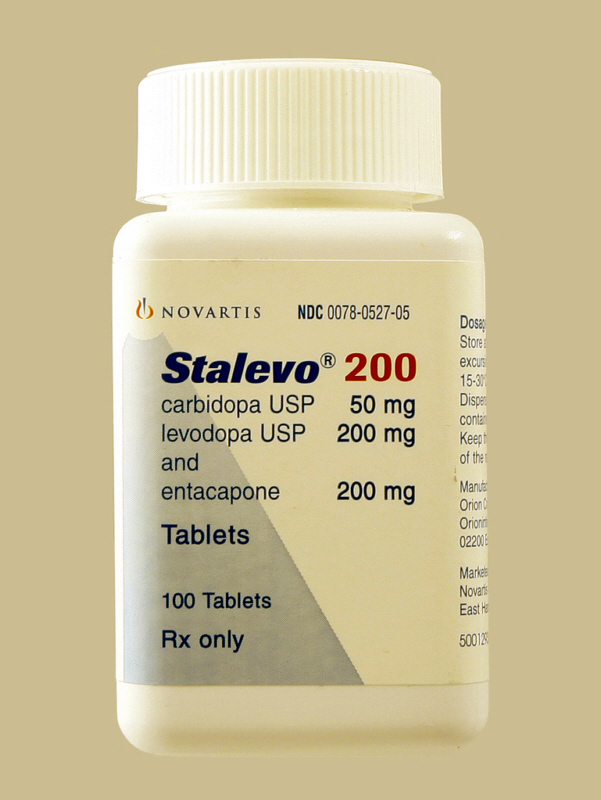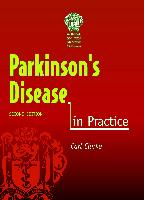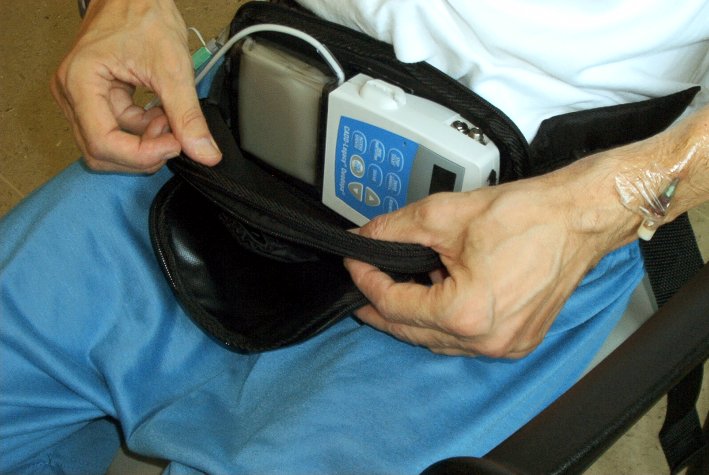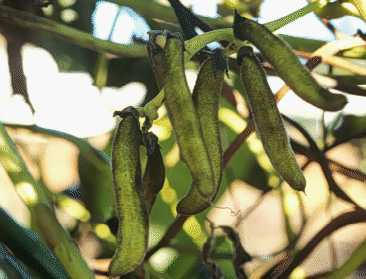31st August 2010 - New review
STALEVO FOR PARKINSON'S DISEASE
Stalevo is a drug for
Parkinson's Disease that is a combination of
L-dopa, carbidopa and entacapone. That is the same as Sinemet plus entacapone.
For more information go to
Stalevo. The therapeutic constituent is L-dopa.
Entacapone is a COMT inhibitor, which is able to slow down the breakdown of
L-dopa. Stalevo is intended for the treatment of people with Parkinson's Disease
who experience signs and symptoms of end-of-dose "wearing off"
[1]. A
series of studies showed that Stalevo and corresponding dosages of L-dopa /
carbidopa plus entacapone had the same effect
[2].
A clinical advantage of Stalevo is that patients can take one pill rather than
two (or more) separate tablets
[2].
 Over 70% of the patients that added entacapone to their Sinemet (or the
equivalent), or that switched to Stalevo, which includes all three, felt that
they were clinically improved. Over 80% of them experienced a reduction in
fluctuations
[3]. About 8% of people that changed to Stalevo
discontinued treatment, mostly because of adverse events. There was also a
tendency for Stalevo to initiate or worsen dyskinesia
[4].
Stalevo resulted in an improvement in symptoms
[4]
[5]
[8]
[11]. There was also an improvement in "on"
time
[9]
[10].
Patients found Stalevo more simple to dose, more convenient to use, easier to
handle, easier to remember and easier to swallow
[7].
A majority of patients preferred Stalevo to L-dopa and carbidopa when in a
sustained release form, and improved their symptoms when they changed over to it
[6].
Over 70% of the patients that added entacapone to their Sinemet (or the
equivalent), or that switched to Stalevo, which includes all three, felt that
they were clinically improved. Over 80% of them experienced a reduction in
fluctuations
[3]. About 8% of people that changed to Stalevo
discontinued treatment, mostly because of adverse events. There was also a
tendency for Stalevo to initiate or worsen dyskinesia
[4].
Stalevo resulted in an improvement in symptoms
[4]
[5]
[8]
[11]. There was also an improvement in "on"
time
[9]
[10].
Patients found Stalevo more simple to dose, more convenient to use, easier to
handle, easier to remember and easier to swallow
[7].
A majority of patients preferred Stalevo to L-dopa and carbidopa when in a
sustained release form, and improved their symptoms when they changed over to it
[6].
The U.S. Food and Drug
Administration (FDA) is evaluating clinical trial data that may suggest that
patients taking Stalevo may be at an increased risk for developing prostate
cancer. Patients taking Stalevo were compared to those taking carbidopa and
levodopa. The number of people
taking Stalevo with prostate cancer was small, but it was still four times what
would otherwise be expected. The FDA consequently suggested that "Patients should not stop taking their
medication unless directed to do so by their healthcare professional"
[12].
They are also evaluating clinical trial data
that suggest patients taking Stalevo may be at an increased risk for
cardiovascular events (heart attack, stroke, and cardiovascular death)
[13]. In order to refer to this
article on its own
click here.
21st August 2010 - New review
LEAD AS A CAUSE OF PARKINSON'S DISEASE
Prolonged exposure to lead can
double the likelihood of developing Parkinson�s Disease
[Complete abstract].
Common means of exposure are : lead contaminated soil, ingestion of lead dust or
chips from deteriorating lead-based paints. Air pollution from the processing of
lead, food grown in contaminated soil, drinking water from plumbing and fixtures
that are either made of lead or have trace amounts of lead in them. Lead can be
found in cosmetics in some countries, some herbal remedies, and even in toys.
For more information go to
Lead Poisoning.
Means
of toxicity : Due to the similarity of their structures, lead can inadvertently
replace iron in enzyme reactions, but lead does not properly function as a
cofactor. This might cause a reduction in L-dopa because iron is an essential
cofactor for L-dopa formation.
 Most lead poisoning symptoms are thought to occur
by interfering with the enzyme Delta-aminolevulinic acid dehydratase (ALAD),
which is required for the formation of hemoglobin, as is ferrochelatase, which
is also interfered with lead. Hemoglobin transports oxygen, which is required
for the formation of L-dopa. So lead may also cause Parkinson's Disease symptoms
by interfering with the availability of oxygen to the brain. However, the
precise means by which it causes Parkinson's Disease has still not been proven.
Most lead poisoning symptoms are thought to occur
by interfering with the enzyme Delta-aminolevulinic acid dehydratase (ALAD),
which is required for the formation of hemoglobin, as is ferrochelatase, which
is also interfered with lead. Hemoglobin transports oxygen, which is required
for the formation of L-dopa. So lead may also cause Parkinson's Disease symptoms
by interfering with the availability of oxygen to the brain. However, the
precise means by which it causes Parkinson's Disease has still not been proven.
Symptoms : Serious and chronic
exposure to lead can more than double the likelihood of developing Parkinson's
Disease, making it 2.27 times more likely. Milder exposure to lead did not
increase the likelihood of Parkinson's Disease
[Complete abstract].
In order to refer to this
article on its own
click here.
17th August 2010 - New book
PARKINSON'S DISEASE IN PRACTICE
Carl E.Clarke
 Publisher's
description : Parkinson's Disease in Practice provides practical, up-to-date
summaries on how to manage Parkinson's disease in everyday practice. The title
reflects the current developments surrounding Parkinson's disease and the fields
of pharmacology and surgery making this an indispensable guide full of tips and
useful advice. This title reviews the entire spectrum of Parkinson's disease,
and includes topics as its epidemiology and aetiology, pathophysiology, and
potential investigations. This book will be of great value to general
practitioners, hospital doctors, Parkinson's Disease Nurse Specialists and
paramedical therapists working in this area, as well as students of medicine, pharmacology and pharmacy
Click here for more details. In order to refer to this
article on its own
click here.
For
more books concerning Parkinson's Disease go to
Parkinson's Disease Books.
Publisher's
description : Parkinson's Disease in Practice provides practical, up-to-date
summaries on how to manage Parkinson's disease in everyday practice. The title
reflects the current developments surrounding Parkinson's disease and the fields
of pharmacology and surgery making this an indispensable guide full of tips and
useful advice. This title reviews the entire spectrum of Parkinson's disease,
and includes topics as its epidemiology and aetiology, pathophysiology, and
potential investigations. This book will be of great value to general
practitioners, hospital doctors, Parkinson's Disease Nurse Specialists and
paramedical therapists working in this area, as well as students of medicine, pharmacology and pharmacy
Click here for more details. In order to refer to this
article on its own
click here.
For
more books concerning Parkinson's Disease go to
Parkinson's Disease Books.
14th August 2010 - New review
DUODOPA FOR PARKINSON'S DISEASE
Duodopa is a combination of
L-dopa and carbidopa in the form of a gel. It is administered throughout the day
using a portable pump directly into the small intestine through a surgically
placed tube. For the
Duodopa fact sheet.
 The
method ensures a flow of L-dopa that can be
adjusted according to the patient's individual needs
[1]. It
enables more consistent plasma concentrations
of L-dopa
[3]. Significant improvements were found with
its use
[2]
[5]
[6].
The side effects are similar
to those observed with oral administration of
L-dopa and carbidopa
[3]
[4].
Dislocation of the intestinal tube to the
stomach was the most common technical
problem
[2]
[3]
[4],
occurring in nearly 70% of the patients during the first year
[4].
Whether L-dopa consumption was reduced or increased with infusion as
compared to oral therapy differed according to the study
[2]
[4]
[6].
In order to refer to this
article on its own
click here.
The
method ensures a flow of L-dopa that can be
adjusted according to the patient's individual needs
[1]. It
enables more consistent plasma concentrations
of L-dopa
[3]. Significant improvements were found with
its use
[2]
[5]
[6].
The side effects are similar
to those observed with oral administration of
L-dopa and carbidopa
[3]
[4].
Dislocation of the intestinal tube to the
stomach was the most common technical
problem
[2]
[3]
[4],
occurring in nearly 70% of the patients during the first year
[4].
Whether L-dopa consumption was reduced or increased with infusion as
compared to oral therapy differed according to the study
[2]
[4]
[6].
In order to refer to this
article on its own
click here.
12th August 2010 - History
SEVENTEENTH CENTURY TREATMENTS OF PARKINSON'S DISEASE
 Nicholas
Culpeper (1616-1654) was an English botanist, herbalist, physician and
astrologer. He published books, The English Physitian (1652) and the
Complete Herbal (1653). The Complete Herbal contains both pharmaceutical
and herbal
knowledge. Among the recommendations he suggests sage
for "sinews, troubled with palsy and cramp". For centuries prior to this,
Sage had also been recommended for tremor in the hands. Amongst other
plant remedies Culpepper suggested for palsy and trembling were
bilberries, briony (called "English mandrake"), and mistletoe. In the 1696
edition of his
Pharmacopoeia Londinensis, a variety
of substances were claimed to be useful
in the
treatment of "palsies", the "dead
palsy", and "tremblings". These included the "oil of winged
ants" and preparations including earthworms !
For
more concerning the history of Parkinson's go to the
History of Parkinson's Disease.
Nicholas
Culpeper (1616-1654) was an English botanist, herbalist, physician and
astrologer. He published books, The English Physitian (1652) and the
Complete Herbal (1653). The Complete Herbal contains both pharmaceutical
and herbal
knowledge. Among the recommendations he suggests sage
for "sinews, troubled with palsy and cramp". For centuries prior to this,
Sage had also been recommended for tremor in the hands. Amongst other
plant remedies Culpepper suggested for palsy and trembling were
bilberries, briony (called "English mandrake"), and mistletoe. In the 1696
edition of his
Pharmacopoeia Londinensis, a variety
of substances were claimed to be useful
in the
treatment of "palsies", the "dead
palsy", and "tremblings". These included the "oil of winged
ants" and preparations including earthworms !
For
more concerning the history of Parkinson's go to the
History of Parkinson's Disease.
9th August 2010 - New review
MUCUNA PRURIENS - THE OLDEST TREATMENT FOR
PARKINSON'S DISEASE
An ancient
civilisation in India practiced their medical doctrine called Ayurveda. They described
the symptoms of Parkinson's Disease, which they called Kampavata as far back as
5000 B.C.. To treat Kampavata, they used Mucuna Pruriens, which is
certainly the oldest known method of treating the symptoms of Parkinson's
Disease.
Mucuna pruriens is a tropical legume whose seeds
are a natural source of high quantities of L-dopa. Immature seeds contain
maximum L-dopa content
[1]. Mucuna Pruriens is a
milder source of L-dopa than the quantities of L-dopa in pharmaceutical forms.
Its mildness lessens the problem of excessive dosage that often occurs with the
use of L-dopa in pharmaceutical form. Mucuna Pruriens is also more adjustable in
its dosages. It can be used for
Parkinson's Disease
as a form of L-dopa
[2].
 In optimal dosages, Mucuna Pruriens acts more quickly than
L-dopa, and its effects last longer. There are no major differences between them
regarding possible side effects
[3]. Mucuna Pruriens also
possesses anti-oxidant qualities, which help to protect against cell damage, and
also metal chelating activity, which helps to protect against excessive
quantities of metals
[4]. There is no evidence
that it contains the equivalent of carbidopa, which is a substance in Sinemet
that reduces L-dopa breakdown before it is reaches the brain.
In order to refer to this article on its own
click here.
In optimal dosages, Mucuna Pruriens acts more quickly than
L-dopa, and its effects last longer. There are no major differences between them
regarding possible side effects
[3]. Mucuna Pruriens also
possesses anti-oxidant qualities, which help to protect against cell damage, and
also metal chelating activity, which helps to protect against excessive
quantities of metals
[4]. There is no evidence
that it contains the equivalent of carbidopa, which is a substance in Sinemet
that reduces L-dopa breakdown before it is reaches the brain.
In order to refer to this article on its own
click here.
3rd August 2010 - New research
THE EFFECT OF BLOWS TO THE HEAD ON PARKINSON'S DISEASE
Movement Disorders [2010]
Jul 28 [Epub ahead of print] (Lolekha P, Phanthumchinda K, Bhidayasiri R.)
Complete abstract
Blows to the head are sometimes claimed to have been a cause of Parkinson's
Disease.
Boxing, with its frequent blows to the head is often believed to be a cause of Parkinsonism because of
chronic repetitive head injury, with Muhammad Ali frequently, but very possibly
wrongly, cited as an
example. Even more extreme and frequent blows to the head occur in Kick Boxing, in which
participants receive not only punches, but also kicks to the head. Kick Boxing is at its
most extreme in Thailand, where it originated, as the sport of
Muay Thai.
As the blows are more powerful and the contests more frequent, Muay Thai tests the impact of blows to the head even more than boxing. In
order to assess the effect of blows to the head, this study determined the
prevalence of Parkinson's Disease in retired Muay Thai boxers.
 Out of over 700
that responded, only 5 of them had Parkinson's Disease, which is not even 1% of
boxers. So boxing, even in the extreme form found in Thailand, did not make
Parkinson's Disease likely, nullifying the claim that boxing and blows to the head commonly
cause Parkinson's Disease. Those Muay Thai boxers that had a large
number of professional contests were found to be a bit more prone to developing
Parkinson's Disease. So frequent blows to the head appear to cause an inclination to
Parkinson's Disease rather than actually cause it. In order to refer to this
article on its own
click here.
Out of over 700
that responded, only 5 of them had Parkinson's Disease, which is not even 1% of
boxers. So boxing, even in the extreme form found in Thailand, did not make
Parkinson's Disease likely, nullifying the claim that boxing and blows to the head commonly
cause Parkinson's Disease. Those Muay Thai boxers that had a large
number of professional contests were found to be a bit more prone to developing
Parkinson's Disease. So frequent blows to the head appear to cause an inclination to
Parkinson's Disease rather than actually cause it. In order to refer to this
article on its own
click here.
.gif)
.gif)
 Over 70% of the patients that added entacapone to their Sinemet (or the
equivalent), or that switched to Stalevo, which includes all three, felt that
they were clinically improved. Over 80% of them experienced a reduction in
fluctuations
Over 70% of the patients that added entacapone to their Sinemet (or the
equivalent), or that switched to Stalevo, which includes all three, felt that
they were clinically improved. Over 80% of them experienced a reduction in
fluctuations  Most lead poisoning symptoms are thought to occur
by interfering with the enzyme Delta-aminolevulinic acid dehydratase (ALAD),
which is required for the formation of hemoglobin, as is ferrochelatase, which
is also interfered with lead. Hemoglobin transports oxygen, which is required
for the formation of L-dopa. So lead may also cause Parkinson's Disease symptoms
by interfering with the availability of oxygen to the brain. However, the
precise means by which it causes Parkinson's Disease has still not been proven.
Most lead poisoning symptoms are thought to occur
by interfering with the enzyme Delta-aminolevulinic acid dehydratase (ALAD),
which is required for the formation of hemoglobin, as is ferrochelatase, which
is also interfered with lead. Hemoglobin transports oxygen, which is required
for the formation of L-dopa. So lead may also cause Parkinson's Disease symptoms
by interfering with the availability of oxygen to the brain. However, the
precise means by which it causes Parkinson's Disease has still not been proven.
 Publisher's
description : Parkinson's Disease in Practice provides practical, up-to-date
summaries on how to manage Parkinson's disease in everyday practice. The title
reflects the current developments surrounding Parkinson's disease and the fields
of pharmacology and surgery making this an indispensable guide full of tips and
useful advice. This title reviews the entire spectrum of Parkinson's disease,
and includes topics as its epidemiology and aetiology, pathophysiology, and
potential investigations. This book will be of great value to general
practitioners, hospital doctors, Parkinson's Disease Nurse Specialists and
paramedical therapists working in this area, as well as students of medicine, pharmacology and pharmacy
Publisher's
description : Parkinson's Disease in Practice provides practical, up-to-date
summaries on how to manage Parkinson's disease in everyday practice. The title
reflects the current developments surrounding Parkinson's disease and the fields
of pharmacology and surgery making this an indispensable guide full of tips and
useful advice. This title reviews the entire spectrum of Parkinson's disease,
and includes topics as its epidemiology and aetiology, pathophysiology, and
potential investigations. This book will be of great value to general
practitioners, hospital doctors, Parkinson's Disease Nurse Specialists and
paramedical therapists working in this area, as well as students of medicine, pharmacology and pharmacy
 The
method ensures a flow of L-dopa that can be
adjusted according to the patient's individual needs
The
method ensures a flow of L-dopa that can be
adjusted according to the patient's individual needs
 Nicholas
Culpeper (1616-1654) was an English botanist, herbalist, physician and
astrologer. He published books, The English Physitian (1652) and the
Complete Herbal (1653). The Complete Herbal contains both pharmaceutical
and herbal
knowledge. Among the recommendations he suggests sage
for "sinews, troubled with palsy and cramp". For centuries prior to this,
Sage had also been recommended for tremor in the hands. Amongst other
plant remedies Culpepper suggested for palsy and trembling were
bilberries, briony (called "English mandrake"), and mistletoe. In the 1696
edition of his
Nicholas
Culpeper (1616-1654) was an English botanist, herbalist, physician and
astrologer. He published books, The English Physitian (1652) and the
Complete Herbal (1653). The Complete Herbal contains both pharmaceutical
and herbal
knowledge. Among the recommendations he suggests sage
for "sinews, troubled with palsy and cramp". For centuries prior to this,
Sage had also been recommended for tremor in the hands. Amongst other
plant remedies Culpepper suggested for palsy and trembling were
bilberries, briony (called "English mandrake"), and mistletoe. In the 1696
edition of his  In optimal dosages, Mucuna Pruriens acts more quickly than
L-dopa, and its effects last longer. There are no major differences between them
regarding possible side effects
In optimal dosages, Mucuna Pruriens acts more quickly than
L-dopa, and its effects last longer. There are no major differences between them
regarding possible side effects
 Out of over 700
that responded, only 5 of them had Parkinson's Disease, which is not even 1% of
boxers. So boxing, even in the extreme form found in Thailand, did not make
Parkinson's Disease likely, nullifying the claim that boxing and blows to the head commonly
cause Parkinson's Disease. Those Muay Thai boxers that had a large
number of professional contests were found to be a bit more prone to developing
Parkinson's Disease. So frequent blows to the head appear to cause an inclination to
Parkinson's Disease rather than actually cause it. In order to refer to this
article on its own
Out of over 700
that responded, only 5 of them had Parkinson's Disease, which is not even 1% of
boxers. So boxing, even in the extreme form found in Thailand, did not make
Parkinson's Disease likely, nullifying the claim that boxing and blows to the head commonly
cause Parkinson's Disease. Those Muay Thai boxers that had a large
number of professional contests were found to be a bit more prone to developing
Parkinson's Disease. So frequent blows to the head appear to cause an inclination to
Parkinson's Disease rather than actually cause it. In order to refer to this
article on its own